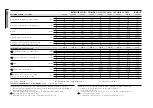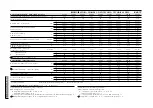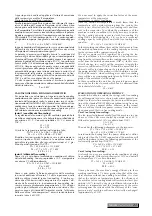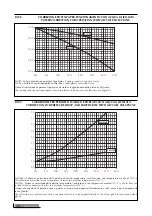
A questo punto si andrà ad applicare il fattore di correzione
della temperatura media all’evaporatore.
Prestazioni nelle condizioni invernali:
Poichè la temperatura dell’aria esterna è ben inferiore alla tempe-
ratura di ritorno dell’ acqua dall’impianto, quest’ ultima viene
deviata prima nelle batterie free-cooling e successivamente invia-
ta all’evaporatore. Per valutare le prestazioni della macchina nelle
condizioni invernali occorre innanzitutto quantificare la potenza
frigorifera recuperata tramite il funzionamento con free-cooling .
Utilizzando la TAV 3 ed ipotizzando
∆
t = 5 K, si vede una poten-
za frigorifera recuperata (con glicole) e con solo free-cooling pari
a :
Pf = 125 x 1,0 x 0,967= 120,8 kW
In queste condizioni di funzionamento si avrà un recupero totale
dall’ambiente esterno della potenza frigorifera necessaria
all’impianto ed i compressori saranno spenti.
La potenza in eccesso verrà regolata tramite la variazione del
numero di giri dei ventilatori inoltre già una minore temperatura
di ritorno dell’acqua dall’impianto renderà minore il recupero di
potenza frigorifera dall’ambiente esterno (TAV 3). In questo caso
varierà anche il
∆
t ed occorrerà applicare i coefficienti correttivi
di TAV 6. Occorre notare che la portata varierà a seconda della
curva di prevalenza della pompa installata. Infatti se il dimensio-
namento della pompa viene fatto per ottenere un certo
∆
t nel
funzionamento refrigeratore, quando si commuterà in free-
cooling si otterrà un nuovo punto di funzionamento dato da
TAV 5 e dalla curva di prevalenza utile pompa.
L’ unità in queste condizioni assorbe al massimo la potenza
necessaria al funzionamento dei ventilatori ricavabile dalla tabella
dei dati tecnici ossia:
Pa = 4 kW
VALUTAZIONE DELLA ECONOMIA DI ESERCIZIO
Per permettere una valutazione sul risparmio con free-cooling
confronteremo due ipotesi di utilizzo alle condizioni di progetto
invernale dell’esempio di scelta: la prima ipotesi sarà di un fun-
zionamento dell’unità NRA F 600 standard senza utilizzo di free-
cooling come fosse un normale refrigeratore. Nella seconda ipo-
tesi invece la utilizzeremo con recupero di potenza gratis
dall’ambiente esterno ossia in modalità free-cooling.
Ipotesi 1 (non utilizzo del free-cooling):
La regolazione del numero di giri dei ventilatori porterebbe la
macchina a condensare come se le batterie fossero raffreddate da
aria esterna a 20 °C. Con acqua prodotta a 10 °C si ricava da
TAV. 1:
Cf = 1,25
Ca = 0,74
L’unità ha le seguenti prestazioni nelle ipotese fatte:
Pf = 116 x 1,25 x 0,967 = 140,2 kW
Pa = 51 x 0,74 x 0,988 = 37,3 kW
Rispetto al carico termico la potenza resa è sicuramente in
eccesso rispetto ai 90 kW richiesti e la macchina tenderà a
parzializzare portandosi alle seguenti prestazioni al 3° gra-
dino di parzializzazione (TAV 19):
Pf = 145,0 x 0,80
≈
112,0 kW
Pa = 37,7 x 0,72
≈
27,1 kW
E.E.R. = 4,13
Ipotesi 2 (utilizzo del free-cooling):
Come si è già visto stiamo lavorando con condizioni di utilizzo
del solo free-cooling. Con acqua prodotta a 10 °C e temperatura
aria esterna 2 °C abbiamo ottenuto:
Pf = 125 x 1,0 x 0,967= 120,8 kW
Pa = 4 kW
E.E.R. = 30,2
Come si può vedere l’efficienza energetica della macchina
in queste condizioni di lavoro è 7,3 volte superiore a quelle
della macchina standard senza free-cooling. E’ inoltre evi-
dente che all’abbassarsi della temperatura aria esterna l’effi-
cienza della macchina in funzionamento free-cooling cre-
scerà in maniera direttamente proporzionale (+10% ad ogni
grado in più di differenza tra temperatura aria esterna e tem-
peratura acqua di ritorno dall’impianto) mentre l’efficienza
della macchina “solo compressori” rimarrà sostanzialmente
invariata (circa 4 di COP).
We now need to apply the correction factor of the mean
temperature at the evaporator.
Performance in winter conditions:
Since the outside air temperature is much lower than the
temperature of the water returning from the system, this
water is first diverted into the free-cooling coils and then
sent to the evaporator. To evaluate the performance of the
machine in winter conditions it is firstly necessary to quan-
tify the cooling capacity recovered with free-cooling. By
using TAB 3 and assuming
∆
t
= 5 K, we have a recovered
cooling capacity (with glycol) and with free-cooling only
equal to:
Pf = 125 x 1.0 x 0.967= 120.8 kW
In these working conditions there will be total recovery from
the outside environment of the cooling capacity necessary
for the system and the compressors will be off.
The excess power will be regulated by varying the fan
speed; in addition, a lower temperature of the water retur-
ning from the system will mean less cooling capacity is reco-
vered from the outside environment (TAB 3). In this case,
Dt will change, too, and it will be necessary to apply the
corrective coefficients of TAB 6. It should be noted that the
flow rate will vary depending on the graph of the head of
the pump installed. If the pump is sized to obtain a certain
Dt in chiller mode, when switching over onto free-cooling
there will be a new operating point given by TAB 5 and the
graph of the useful head of the pump.
In these conditions the unit has the greatest power input
necessary for the fans to work, which can be obtained from
the technical data table, i.e.:
Pa = 4 kW
EVALUATION OF OPERATING EFFICIENCY
In order to be able to evaluate the savings with free-cooling
we will compare two cases of use under winter project con-
ditions for the selection example: the first case will be opera-
tion of the standard NRA F 600 unit without using free-coo-
ling as if it were a normal chiller. Whereas, in the second
case we will use it with free power recovery from the outsi-
de environment, that is in free-cooling mode.
Case 1 (not using free-cooling):
The fan speed adjustment would lead the machine to con-
dense as if the coils were cooled by outside air at 20°C.
With water processed at 10°C we obtain from TAB. 1:
Cf = 1.25
Ca = 0.74
The unit has the following performance in the two cases:
Pf = 116 x 1.25 x 0.967 = 140.2 kW
Pa = 51 x 0.74 x 0.988 = 37.3 kW
In relation to the heating load, the power delivered is defini-
tely greater than the 90 kW required and the machine will
tend to step down to have the following performance at the
3rd capacity control step (TAB 19):
Pf = 145.0 x 0.80
≈
112.0 kW
Pa = 37.7 x 0.72
≈
27.1 kW
E.E.R. = 4.13
Case 2 (using free-cooling):
As already seen, we are working under conditions of using
free-cooling only. With water processed at 10°C and outside
air temperature 2°C we have obtained:
Pf = 125 x 1.0 x 0.967= 120.8 kW
Pa = 4 kW
E.E.R.
= 30.2
As may be seen, the machine's energy efficiency in these
working conditions is 7.3 times greater than that of the stan-
dard machine without free-cooling. In addition, it is clear
that as the outside air temperature lowers, the efficiency of
the machine in free-cooling mode will increase in direct pro-
portion (+10% for each extra step in difference between the
outside air temperature and the temperature of the water
returning from the system) while the efficiency of the "com-
pressors only" machine will remain basically unchanged
(approximately 4 COP).
NRA Fc
Cod. 6871970_00
21
Содержание NRA F 275
Страница 2: ...2 Aermec S p A ...
















































